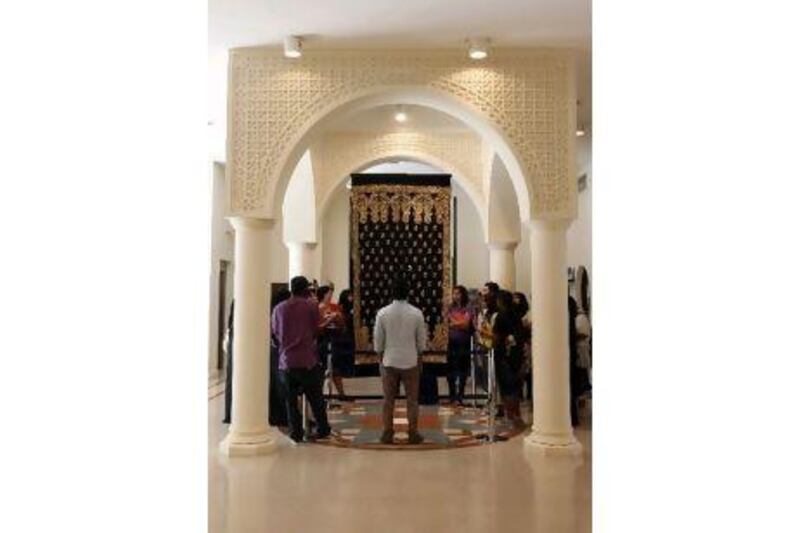SHARJAH // The artwork may have taken weeks or months to create but students were given just eight minutes yesterday to explain what piece was their favourite from the Sharjah Biennial.
More than 50 school and university students turned critic on the final day of the region's largest art show. Some went for a blinding light, others opted for the tattooed figures.
And in the spirit of the event, alone or in groups they presented their top pick in the medium of their choice such as artwork, poetry, conversation, video or performance.
"All the artists who produced their art and presented it at the Biennial somehow displayed their views about the world," said Shaista Khadim, from Ibn Seena High School. "I understand art better now - the Biennial made me realise how every artist has his way to express himself."
Shaista and her schoolmate Suha Nasir, both 16 and from Pakistan, chose an installation called Lament of the Images by Alfredo Jaar as their favourite. The piece consists of a large room that is divided into two. The first part is dark and has three texts on display, and the second has a large bright rectangular light hanging on a wall.
Suha said: "Leaving the museum, it was the only thing in my head. Basically you choose what to see. Even though it was meant to be sad, like lament, but I found freedom in that installation. The Biennial was a new experience, it opened my eyes to art."
Shaista added: "This man could have put up a picture but he chose to put up a screen that emitted blinding light. So what I realised was that truth does not always lie in images, sometimes it lies in things like light and you have to perceive it."
However, the students said more straightforward representational works also caught their eye, such as Marie-Hélène Cauvin's portraits of tattooed figures.
"I really like the way she represented tattoos, how people put tattoos on their bodies and how the tattoos show the character of the person," said Shaista.
The special event was called Talk 8, and each presentation lasted about six minutes and was followed by two minutes of discussion and questions from fellow students and members of the public at the Sharjah Art Museum.
Institutions taking part included the College of Fine Art and Design, the University of Sharjah, the College of Architecture and Design, the American University of Sharjah and Al Amal School for the Deaf.
Usha Ramakrishna, an Ibn Seena humanities teacher, said her pupils' involvement in the Biennial and Talk 8 had opened up numerous doors and opportunities.
"This is a wonderful platform for these children because they have so much creativity in them, but it's all so muddled up. Most of these children draw, they're creative, but this Biennial has given them a better perspective.
"Art is a medium of expression, it's a universal language, and the Biennial has allowed these children to really get their creative juices going. Each one is so excited and so enthusiastic - many of them were introverts and now I see them really gelling with the team, coming out with ideas, saying so much."
Sharjah Biennial 10: Plot for a Biennial featured works by more than 120 artists from around the world displayed in venues spread across the arts and heritage area of the Corniche over two months.
Farah Atoui, the head of communications for the Sharjah Art Foundation, which runs the Biennial, said this year's show had attracted the most visitors.
"We haven't worked out the final figures yet but this is definitely the year we've had most visitors, people were interested in the art and the Biennial," she said. "We've had visitors from South America, North America, Europe, Japan - a mixed global crowd.
"It's also the year we've had the highest number of commissions, 65, so we've helped to provide art, not just bring in existing works. And our outreach and education programme featured a lot of workshops designed to engage with the public."






